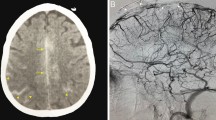Abstract
Background
Spontaneous, non traumatic subarachnoid hemorrhage (SAH) is a significant clinical problem that occurs most commonly as a result of aneurysm rupture. In approximately 15 % of cases, nor aneurysm or other vascular malformation can be identified by cerebral angiography as origin of the hemorrhage, and these are commonly defined as idiopathic SAH (ISAH). Because of the negative angiography, limited extension of the bleeding with prevalent prepontine pattern and the benign prognosis, the venous causes has been preferred rather than the arterial ones. In the literature recent studies have suggested a possible contribution by primitive variants of Basal vein of Rosenthal (BVR) in its the pathogenesis of ISAH, commonly grouped according Watanabe classification (type A, B and C). In this paper we evaluated the prevalence of anatomical variants of BVR in ISAH.
Methods
Venous drainage at angiography was retrospectively analyzed in 40 patients with ISAH and in 40 with unruptured aneurysms as controls.
Results and conclusions
Previous studies displayed a significant prevalence of BVR type C variants in ISAH. Conversely in our study we recognized variant B as prevalent, in which the BVR bifurcates to drain anteriorly into the uncal vein and posteriorly into the Galenic system. Similarly to variant C (in which the BVR drains via perimesencephalic “bridging” veins into cavernous, sphenoparietal, petrosal sinus or directly into transverse sinus) also variant B might be subjected to those stress mechanisms and intrinsic system ‘fragility’ and for reasons yet to determine, sets off a consequent hemorrhage with clinical and radiological features typical of ISAH.




Similar content being viewed by others
References
Alen JF, Lagares A, Campollo J, Ballenilla F, Kaen A, Nunez AP, Lobato RD (2008) Idiopathic subarachnoid hemorrhage and venous drainage: are they related? Neurosurgery 63:1106–1111, discussion 1111–1102
Daenekindt T, Wilms G, Thijs V, Demaerel P, Van Calenbergh F (2008) Variants of the basal vein of Rosenthal and perimesencephalic nonaneurysmal hemorrhage. Surg Neurol 69:526–529, discussion 529
Hudak I, Lenzser G, Lunenkova V, Doczi T (2013) Cerebral arterial fenestrations: a common phenomenon in unexplained subarachnoid haemorrhage. Acta Neurochir (Wien) 155:217–222
Hunt WE, Hess RM (1968) Surgical risk as related to time of intervention in the repair of intracranial aneurysms. J Neurosurg 28:14–20
Jennett B, Bond M (1975) Assessment of outcome after severe brain damage. Lancet 1:480–484
Rinkel GJ, van Gijn J, Wijdicks EF (1993) Subarachnoid hemorrhage without detectable aneurysm. A review of the causes. Stroke 24:1403–1409
Sabatino G, Della Pepa GM, Albanese A, Marchese E (2013) Angiogram-negative subarachnoid hemorrhage: is it a correct definition? Acta Neurochir (Wien) 155:1127–1129
Schievink WI, Wijdicks EF (2000) Origin of pretruncal nonaneurysmal subarachnoid hemorrhage: ruptured vein, perforating artery, or intramural hematoma? Mayo Clin Proc 75:1169–1173
Song JH, Yeon JY, Kim KH, Jeon P, Kim JS, Hong SC (2010) Angiographic analysis of venous drainage and a variant basal vein of Rosenthal in spontaneous idiopathic subarachnoid hemorrhage. J Clin Neurosci 17:1386–1390
Van Calenbergh F, Plets C, Goffin J, Velghe L (1993) Nonaneurysmal subarachnoid hemorrhage: prevalence of perimesencephalic hemorrhage in a consecutive series. Surg Neurol 39:320–323
van der Schaaf IC, Velthuis BK, Gouw A, Rinkel GJ (2004) Venous drainage in perimesencephalic hemorrhage. Stroke 35:1614–1618
Watanabe A, Hirano K, Kamada M, Imamura K, Ishii N, Sekihara Y, Suzuki Y, Ishii R (2002) Perimesencephalic nonaneurysmal subarachnoid haemorrhage and variations in the veins. Neuroradiology 44:319–325
Yamakawa H, Ohe N, Yano H, Yoshimura S, Iwama T (2008) Venous drainage patterns in perimesencephalic nonaneurysmal subarachnoid hemorrhage. Clin Neurol Neurosurg 110:587–591
Conflicts of interest
None.
Author information
Authors and Affiliations
Corresponding author
Rights and permissions
About this article
Cite this article
Sabatino, G., Della Pepa, G.M., Scerrati, A. et al. Anatomical variants of the basal vein of Rosenthal: prevalence in idiopathic subarachnoid hemorrhage. Acta Neurochir 156, 45–51 (2014). https://doi.org/10.1007/s00701-013-1907-6
Received:
Accepted:
Published:
Issue Date:
DOI: https://doi.org/10.1007/s00701-013-1907-6




